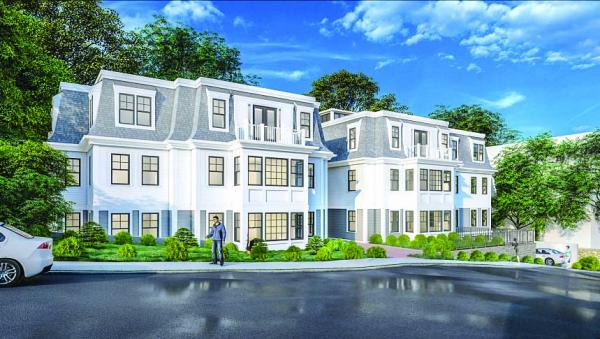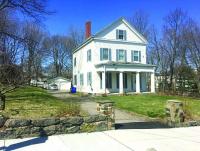September 17, 2021

A rendering of the most recent design reflects many wishes from the abutters and neighbors – a three-story building with a Mansard roof, and a third of the units first proposed two years ago.

The Boston Landmarks Commission (BLC) and several other interested parties are in the middle of an intense discussion about the fate of the old Swan House at 29 High St., with preservationists calling for the house to be saved while a developer backed by some neighbors is ready to move on with a new building project.
On Tuesday night, after the Reporter’s deadline, the commission held a meeting to look at the alternatives to demolishing the home on Meetinghouse Hill, which was given a preliminary determination of historical significance earlier this year by BLC. That larger process of historical preservation, according to the Landmarks panel’s director, Roseanne Foley, wasn’t scheduled to be discussed at this week’s hearing, but will be taken up at a later date.
As it now stands, the developer, Fernando Dalfior, and many abutters argue that the house needs to come down to make way for what the neighborhood and developer have agreed on.
However, the Dorchester Historical Society (DHS) and several preservation-minded residents have called on the Landmarks Commission to delay demolition and look into protecting the entire property, which consists of nearly one acre of land on the north slope of Meetinghouse Hill.
Already, Foley said, Landmarks has accepted a petition from DHS to designate the property an historical landmark, and given a preliminary determination to that effect in January on four out of five of the set criteria. Now, a study of that petition and the historical significance of the property is underway.
“The building is not completely unprotected, (as) the BLC accepted a petition to designate the property and a study report process is underway,” she wrote in an e-mail. “The BLC reviews proposed changes to pending landmarks as part of an accelerated design review process.”
Earl Taylor, president of the DHS, said it is consistent with BLC policy to send any application to the full Commission for a Demolition Delay (known as Article 85) hearing if there is a “hint” of historical significance to the property. Further meetings on the actual application are yet to be scheduled, Foley said.
“There was a petition filed in the winter to make the property at 29 High Street a single-family architectural district,” Taylor wrote in an e-mail. “The Commission approved, and the next steps should be proceeding…There will need to be a commission set up to establish guidelines for the property and to review requests for changes. I don’t know how that process fits with an application by the property owner to demolish the building.”
Abutters and preservationists are often on the same page about keeping an historic home intact. In this case, Dalfior, president of Dalfior Development Inc., said he has gone through several iterations of the project with neighbors and has arrived at a project that most like and support. That project includes 23 units of apartment housing in a three-story building with a Mansard roof.
Dalfior purchased the property two years ago and began talks with neighbors.
“We’ve been working with the neighbors and abutters a long time,” he said. “We started with a large building and we even went out and got an architect to accommodate what the neighbors would want to see…We went back and forth a lot of times. It’s a big piece of land. It’s almost an acre and it’s unheard of in the city.
“We’ve done everything they requested,” he added. “We examined all the options and we changed the design probably five times. It think we’re very close to the finish line. If they want to preserve the home, they’ll definitely be going against the abutters’ opinions because they want the house down and want this new building. That’s where we’re at now.
“I’m indifferent, but at this point it’s been two years and everyone wants to see the project go forward.”
Tom Whall, an abutter on High Street, supports the project and would like to see the old house come down. He said that when Dalfior first came into the neighborhood and proposed the larger building, it didn’t go well, but they’ve worked together and he supports the current proposal.
“He came over and sat at my dining room table and showed me what he wanted to do and I laughed him out of the house,” said Whall. “It would have been nice for it to stay as a one- or two-family estate with some doctor from City Hospital renovating it, but that’s just not the way it is these days. I support the development the way he has proposed it. I think that house is a piece of trash now and it needs to come down…I’m a lifer here and the times for that house have passed. I played with the Allen children when I was a kid, but there aren’t eight children there anymore. It’s a concept that’s passed…If we don’t get this, I’m afraid we would get something like those 60 units there that I opposed.”
He said most of his neighbors also support the current proposal, and Dalfior said the civic association has also backed the most recent proposal. However, preservationists and Landmarks are looking closely at the significance of the property, as it goes far back into Dorchester’s history.
The home is known as the Swan House after Robert Swan, who was a schoolteacher and principal, according to a petition filed by DHS. He is known to have worked at the Mayhew School and the Winthrop School, stressing the introduction of industrial education, and the former Thetford Avenue School was named for him.
His father, William Swan, conveyed the property at 29 High St. to him in 1848. The building first appears on maps in 1850 and it is noted for being one of the few Greek Revival-style homes in Dorchester. In 1918, Swan family heirs turned the property over to the First Parish Church, which is only a block away. The church used the home as its parsonage from that time until 2018.
One notable resident of the home in modern times was the beloved Rev. James K. Allen, who died in 1991 and was known for his role in standing up for issues of diversity and inclusion.



